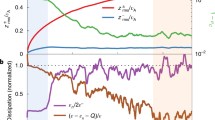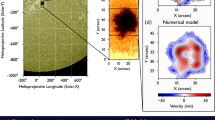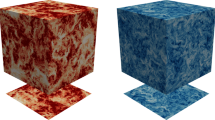Abstract
Present theories suggest two classes of excitation processes which may be responsible for the observed amplitudes of solar p-mode oscillations—self-excitation of the modes via an overstability mechanism such as the K mechanism 2, and stochastic excitation by turbulent convection2–4. We now have data which stand in support of the latter mechanism. Linear overstability calculations are still ambiguous, because of the uncertainties involved in including turbulent viscous damping of the modes. Nevertheless no calculation predicts overstable f-modes, and these modes are observed on the Sun. Furthermore no nonlinear damping mechanism has yet been proposed which would limit the growth of overstable modes to their observed amplitudes. Assuming the modes are stably damped, the theory of mode excitation by convective turbulence now gives mode amplitudes that are in agreement with observations4. In this letter we use data from Big Bear Solar Observatory to compare theory and observation in detail. In particular, our data show that the energy per oscillation mode is nearly constant at low mode frequencies, and is approximately independent of degree at low degrees. The total energy in all the oscillation modes is estimated at ∼1034erg.
This is a preview of subscription content, access via your institution
Access options
Subscribe to this journal
Receive 51 print issues and online access
$199.00 per year
only $3.90 per issue
Buy this article
- Purchase on Springer Link
- Instant access to full article PDF
Prices may be subject to local taxes which are calculated during checkout
Similar content being viewed by others
References
Ando, H. & Osaki, Y. Publ. Astron. Soc. Jap. 27, 581–603 (1975).
Goldreich, P. & Keeley, D. A. Astrophys. J. 211, 934–942 (1977).
Goldreich, P. & Keeley, D. A. Astrophys. J. 212, 243–251 (1977).
Goldreich, P. & Kumar, P. I.A.U. Symp. 123, (1986).
Deubner, F.-L. & Gough, D. A. Rev. Astron. Astrophys. 22, 593–619 (1984).
Christensen-Dalsgaard, J. & Frandsen, S. Solar Phys. 82, 165–204 (1983).
Libbrecht, K. G. & Zirin, H. Astrophys. J. (submitted).
Zirin, H. Aust. J. Phys. 38, 961–969 (1985).
Parnell, R. L. & Beckers, J. M. Solar Phys. 9, 35–38 (1969).
Author information
Authors and Affiliations
Rights and permissions
About this article
Cite this article
Libbrecht, K., Popp, B., Kaufman, J. et al. The excitation and damping of solar oscillations. Nature 323, 235–238 (1986). https://doi.org/10.1038/323235a0
Received:
Accepted:
Issue Date:
DOI: https://doi.org/10.1038/323235a0
This article is cited by
-
Solar oscillations and the equation of state
The Astronomy and Astrophysics Review (1992)
-
Mixing-length theory and the excitation of solar acoustic oscillations
Solar Physics (1990)
-
High-resolution analysis of solar photospheric oscillations
Solar Physics (1990)
-
Rotational enhancement of Doppler measurements of solar and stellar hexadecapole oscillations
Solar Physics (1989)
Comments
By submitting a comment you agree to abide by our Terms and Community Guidelines. If you find something abusive or that does not comply with our terms or guidelines please flag it as inappropriate.



